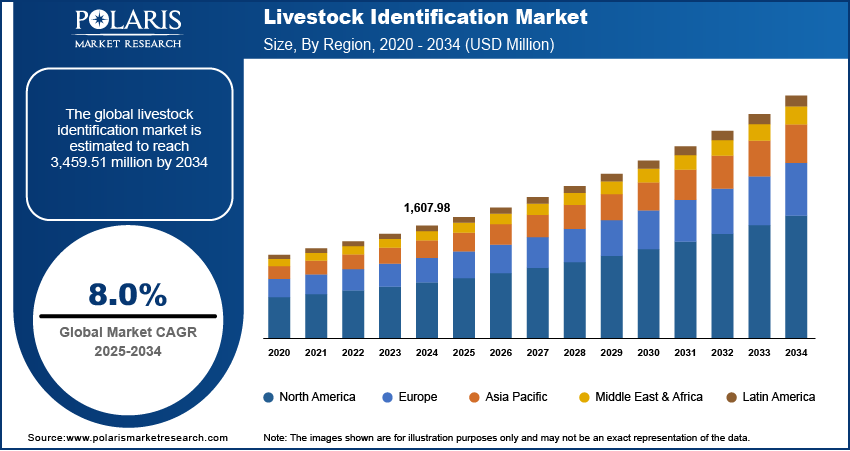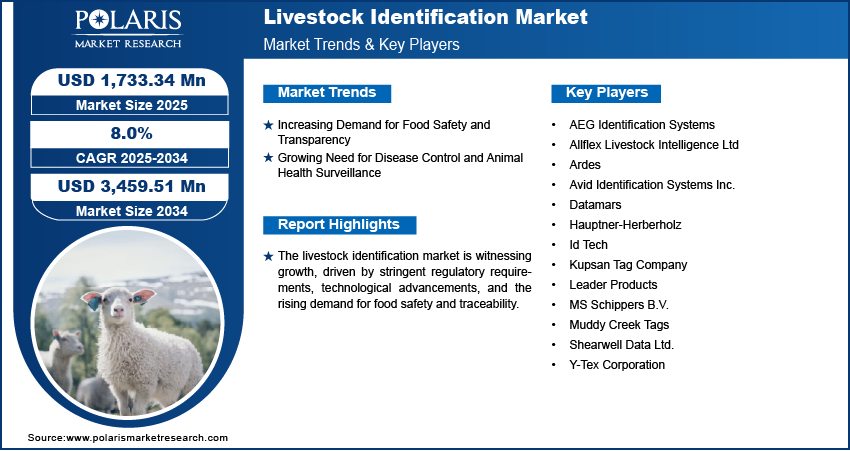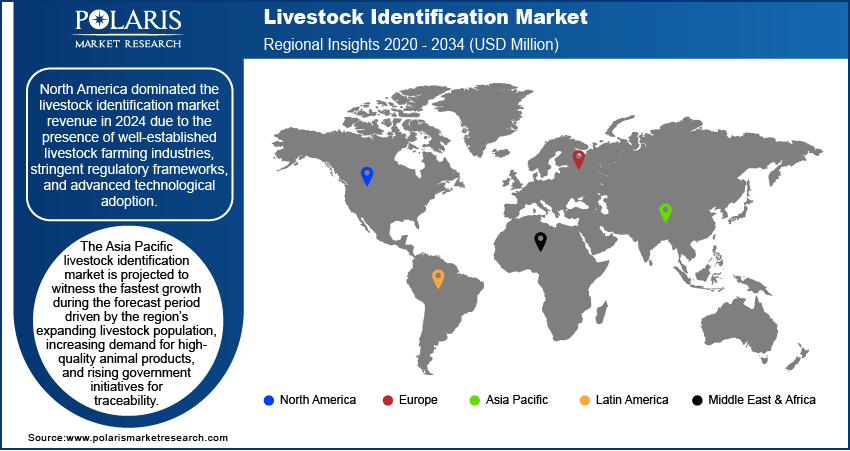
Livestock Identification Market Size, Share, Trends, Industry Analysis Report: By Application, Device Lifecycle (Short and Long), Farm Size, Livestock Type, Offering, and Region (North America, Europe, Asia Pacific, Latin America, and Middle East & Africa) – Market Forecast, 2025–2034
- Published Date:Apr-2025
- Pages: 116
- Format: PDF
- Report ID: PM5480
- Base Year: 2024
- Historical Data: 2020-2023
Livestock Identification Market Overview
The global livestock identification market size was valued at USD 1,607.98 million in 2024. It is expected to grow from USD 1,733.34 million in 2025 to USD 3,459.51 million by 2034, at a CAGR of 8.0% during 2025–2034.
Livestock identification is the process of tagging, tracking, and managing animals using various identification methods to ensure traceability, disease control, and livestock management. The imposition of strict government regulations and rapid technological advancements primarily drive the livestock identification market growth. Governments worldwide have implemented strict regulations to improve food safety testing, prevent disease outbreaks, and improve supply chain transparency. For instance, A February 2025 USDA report highlights the importance of accurate livestock identification for disease traceability. Veterinarians must record official IDs on certificates of veterinary inspection, and ear tags must be durable and tamper-resistant. These regulations mandate the use of unique identification systems, such as RFID tags, ear tags, and biometric identification, ensuring compliance with international livestock trade standards. As a result, livestock owners and agribusinesses are increasingly adopting identification solutions to meet regulatory requirements and improve operational efficiency.

To Understand More About this Research: Request a Free Sample Report
Technological advancements play a major role in transforming the livestock identification market development by offering innovative and efficient solutions. The integration of RFID technology, GPS tracking, and blockchain-based traceability systems has greatly improved livestock monitoring and data management. For instance, in July 2024, Leader Products launched the GPScanID 150 and GPScanID 80 RFID readers, designed to enhance livestock management. The GPScanID 150 offers high accuracy, durability, user-friendly operation, long battery life, and built-in GPS for efficient tracking in large-scale operations. These advancements allow real-time tracking, automated data collection, and improved record-keeping, reducing the risk of fraud and improving biosecurity measures. Additionally, the development of smart sensors and cloud-based management platforms has further streamlined livestock monitoring, providing farmers with actionable insights to optimize productivity. Therefore, as technology continues to evolve, the adoption of advanced livestock identification solutions is expected to improve further efficiency, sustainability, and compliance in the livestock industry.
Livestock Identification Market Dynamics
Increasing Demand for Food Safety and Transparency
Ensuring food safety requires robust identification systems that track livestock from birth to consumption, reducing the risk of contamination, fraud, and unethical practices. Governments and industry stakeholders are implementing strict traceability measures to maintain product integrity and comply with global trade standards as consumers and regulatory bodies emphasize the need for traceable and high-quality animal products. For instance, in April 2023, FAO and North Macedonia launched the second phase of upgrading the veterinary information system to meet EU standards. The project introduces advanced software to improve animal identification, traceability, and food safety, improving public health, animal welfare, and market access. Livestock identification solutions, such as RFID tags, DNA testing, and digital databases, improve supply chain transparency, allowing stakeholders to verify the origin, health status, and treatment history of animals. This growing emphasis on food safety and consumer trust is driving the livestock identification market development.
Growing Need for Disease Control and Animal Health Surveillance
The risk of disease outbreaks in livestock populations poses substantial threats to food security, public health, and economic stability, necessitating efficient tracking and monitoring mechanisms. Identification solutions enable real-time data collection on animal movement, vaccination records, and disease history, allowing authorities and farmers to implement timely interventions. These systems support early disease detection, reduce the spread of infections, and improve biosecurity measures across farms and supply chains. For instance, a February 2023 report by DAHD emphasized India's Livestock Health & Disease Control scheme, which aims to improve animal health through vaccination and improved veterinary infrastructure. Objectives include eliminating PPR by 2030, controlling CSF, deploying mobile veterinary units, and strengthening disease surveillance with central-state funding. Such initiatives underscore the importance of livestock identification systems in achieving these goals. These technologies help mitigate economic losses, improve animal welfare, and ensure a more resilient and sustainable livestock sector by facilitating proactive health management. Hence, the growing need for disease control and animal health surveillance fuels the livestock identification market demand.

Livestock Identification Market Segment Assessment
Livestock Identification Market Assessment by Livestock Type Outlook
The global livestock identification market segmentation, based on livestock type, includes cattle, poultry, swine, and others. The cattle segment dominated the livestock identification market share in 2024 due to the large-scale cattle farming industry and stringent traceability regulations governing beef and dairy production. Cattle require robust identification systems to ensure disease control, breeding management, and compliance with food safety standards. Governments and regulatory bodies have mandated unique identification solutions, such as RFID ear tags and biometric markers, to track cattle movement and health records. Additionally, the rising demand for high-quality meat and dairy products has driven the adoption of advanced identification technologies to enhance supply chain transparency. The necessity for efficient herd management and increasing investments in cattle traceability solutions have further contributed to the segment’s market leadership.
Livestock Identification Market Evaluation by Offering Outlook
The global livestock identification market segmentation, based on offering, includes hardware, software, and services. The software segment is expected to witness the fastest growth during the forecast period due to the increasing need for real-time data analytics, automated record-keeping, and cloud-based livestock management solutions. Modern identification technologies generate vast amounts of data related to animal health, movement, and productivity, requiring advanced software solutions for efficient processing and decision-making. Farmers and agribusinesses are increasingly adopting AI-driven analytics, mobile applications, and cloud-based platforms to streamline livestock monitoring and regulatory compliance. Additionally, software solutions facilitate seamless integration with hardware components, such as RFID readers and GPS trackers, enhancing operational efficiency. The growing shift toward precision livestock farming and digital transformation in animal agriculture is further driving the rapid expansion of the software segment.

Livestock Identification Market Regional Analysis
By region, the report provides livestock identification market insights into North America, Europe, Asia Pacific, Latin America, and the Middle East & Africa. North America dominated the livestock identification market revenue in 2024 due to the presence of well-established livestock farming industries, stringent regulatory frameworks, and advanced technological adoption. The region has implemented comprehensive livestock traceability programs to ensure food safety, disease prevention, and supply chain transparency. In April 2024, USDA's APHIS strengthened animal disease traceability regulations for cattle and bison to improve rapid response to foreign animal diseases. The rule mandates official ear tags for interstate movement, improves regional disease containment, and supports maintaining trade by establishing disease-free zones. High consumer awareness regarding meat and dairy product quality, along with government initiatives supporting livestock identification, has further driven growth opportunities. Additionally, North American livestock producers are early adopters of innovative identification solutions, such as blockchain traceability, RFID technology, and smart sensors. The integration of digital livestock management platforms and strong investments in aggrotech advancements have reinforced the region’s leadership in the market.
The Asia Pacific livestock identification market is projected to witness the fastest growth during the forecast period driven by the region’s expanding livestock population, increasing demand for high-quality animal products, and rising government initiatives for traceability. Rapid urbanization and changing dietary preferences are fueling meat and dairy consumption, necessitating improved livestock tracking systems. Additionally, the region is witnessing growing concerns over disease outbreaks, prompting governments to mandate robust identification and biosecurity measures. For instance, a January 2025 report by the FAO highlighted a new outbreak in Bayankhutag sum (district) in central-eastern Mongolia. On the affected farm, 58 pigs fell ill, 53 died, and 277 pigs were culled to contain the spread. Such incidents highlight the urgent need for effective livestock identification systems to prevent and manage disease outbreaks. Advancements in digital agriculture, increasing investments in precision livestock farming, and the adoption of cost-effective identification technologies are further accelerating the Asia Pacific livestock identification market expansion.

Livestock Identification Market Key Players & Competitive Analysis Report
The competitive landscape features global leaders and regional players competing for livestock identification market share through innovation, strategic alliances, and regional expansion. Global players utilize strong R&D capabilities, technological advancements, and extensive distribution networks to deliver advanced solutions, meeting the growing demand for disruptive technologies and sustainable value chains. Livestock identification market trends highlight rising demand for emerging technologies, digitalization, and business transformation driven by economic growth, geopolitical shifts, and macroeconomic trends. Global players focus on strategic investments, mergers and acquisitions, and joint ventures to strengthen their market position. Post-merger integration and strategic alliances are key strategies to improve competitive positioning and expand regional footprints. Regional companies address localized needs by offering cost-effective solutions and leveraging economic landscapes. Competitive benchmarking includes market entry assessments, expansion opportunities, and partnership ecosystems to meet the demand for innovative products and future-ready solutions. The market is experiencing technological advancements, such as disruptive technologies and digital transformation, reshaping industry ecosystems. Companies are investing in supply chain management, procurement strategies, and sustainability transformations to align with livestock identification market demand, trends, and future development strategies. Pricing insights, revenue growth analysis, and competitive intelligence are critical for identifying opportunities and driving long-term profitability. A few key major players are AEG Identification Systems, Allflex Livestock Intelligence Ltd, Ardes, Avid Identification Systems Inc., Datamars, Hauptner-Herberholz, Id Tech, Kupsan Tag Company, Leader Products, MS Schippers B.V., Muddy Creek Tags, Shearwell Data Ltd., and Y-Tex Corporation.
MS Schippers B.V. is a Dutch company that has been in the agricultural sector since 1966. They are best known for inventing plastic ear tags, which are now a legal requirement for cattle and pigs in many countries. Their primary focus has evolved to encompass a broader range of products and services aimed at improving hygiene in livestock farming. MS Schippers produces around 300 million ear tags annually, but their expertise extends beyond identification to include innovative hygiene solutions designed to reduce antibiotic use and improve animal health. The company operates globally with a presence in over 40 countries, offering a comprehensive range of products and digital services tailored to meet the needs of intensive livestock farming. Although livestock identification remains a part of their offerings, MS Schippers' strategic focus is on holistic farm hygiene management, positioning them as a leader in supporting sustainable and healthy livestock practices worldwide.
ARDES is a company specializing in animal identification solutions, particularly in the livestock sector. ARDES has been manufacturing high-performance products in France, catering to the needs of cattle, sheep, goat, and swine breeders. Their product range includes electronic ear tags, visual ear tags, and accessories such as indelible marking pens and applicators. ARDES electronic ear tags are designed with RFID technology, available in HDX and FDX formats, and are certified by the International Committee for Animal Recording, ensuring compatibility with ISO standards readers. These tags support various farm management solutions, such as herd management software, milking parlor assistance, and automatic weighing systems. In the broader context of livestock identification, the market is driven by strict government regulations, food safety concerns, and the adoption of advanced technologies such as RFID and IoT. ARDES' products align with these trends by providing reliable and efficient identification solutions that integrate well with modern farm management systems. Their commitment to quality and innovation positions them as a key player in the livestock identification sector, supporting farmers in managing their livestock more effectively.
List of Key Companies in Livestock Identification Market
- AEG Identification Systems
- Allflex Livestock Intelligence Ltd
- Ardes
- Avid Identification Systems Inc.
- Datamars
- Hauptner-Herberholz
- Id Tech
- Kupsan Tag Company
- Leader Products
- MS Schippers B.V.
- Muddy Creek Tags
- Shearwell Data Ltd.
- Y-Tex Corporation
Livestock Identification Industry Development
January 2025: Queclink Wireless Solutions and Leader Products launched GPS tracking ear tags for livestock. The tags offer real-time monitoring, geofencing, and health insights, aiming to enhance traceability, security, and herd management across diverse regions and conditions.
January 2025: Laipson launched 860MHz UHF RFID TPU ear tags for pig, goat, and cow tracking. These tags enable livestock identification, traceability, and data collection, featuring tamper-proof ID codes, easy installation, and efficient management for farms, slaughterhouses, and disease control.
Livestock Identification Market Segmentation
By Application Outlook (Revenue, USD Million, 2020–2034)
- Breeding Record
- Animal Ownership Identification
- Disease Management & Control
- Milk Traceability
By Device Lifecycle Outlook (Revenue, USD Million, 2020–2034)
- Short
- Long
By Farm Size Outlook (Revenue, USD Million, 2020–2034)
- Small
- Medium
- Large
By Livestock Type Outlook (Revenue, USD Million, 2020–2034)
- Cattle
- Poultry
- Swine
- Others
By Offering Outlook (Revenue, USD Million, 2020–2034)
- Hardware
- Software
- Services
By Regional Outlook (Revenue, USD Million, 2020–2034)
- North America
- US
- Canada
- Europe
- Germany
- France
- UK
- Italy
- Spain
- Netherlands
- Russia
- Rest of Europe
- Asia Pacific
- China
- Japan
- India
- Malaysia
- South Korea
- Indonesia
- Australia
- Vietnam
- Rest of Asia Pacific
- Middle East & Africa
- Saudi Arabia
- UAE
- Israel
- South Africa
- Rest of Middle East & Africa
- Latin America
- Mexico
- Brazil
- Argentina
- Rest of Latin America
Livestock Identification Market Report Scope
|
Report Attributes |
Details |
|
Market Size Value in 2024 |
USD 1,607.98 million |
|
Market Size Value in 2025 |
USD 1,733.34 million |
|
Revenue Forecast by 2034 |
USD 3,459.51 million |
|
CAGR |
8.0% from 2025 to 2034 |
|
Base Year |
2024 |
|
Historical Data |
2020–2023 |
|
Forecast Period |
2025–2034 |
|
Quantitative Units |
Revenue in USD Million and CAGR from 2025 to 2034 |
|
Report Coverage |
Revenue Forecast, Market Competitive Landscape, Growth Factors, and Industry Trends |
|
Segments Covered |
|
|
Regional Scope |
|
|
Competitive Landscape |
|
|
Report Format |
|
|
Customization |
Report customization as per your requirements with respect to countries, regions, and segmentation. |
FAQ's
The global livestock identification market size was valued at USD 1,607.98 million in 2024 and is projected to grow to USD 3,459.51 million by 2034.
The global market is projected to register a CAGR of 8.0% during the forecast period.
North America dominated the market revenue in 2024.
A few of the key players in the market are AEG Identification Systems, Allflex Livestock Intelligence Ltd, Ardes, Avid Identification Systems Inc., Datamars, Hauptner-Herberholz, Id Tech, Kupsan Tag Company, Leader Products, MS Schippers B.V., Muddy Creek Tags, Shearwell Data Ltd., and Y-Tex Corporation.
The cattle segment dominated the livestock identification market share in 2024.
The software segment is expected to witness the market growth rate during the forecast period
